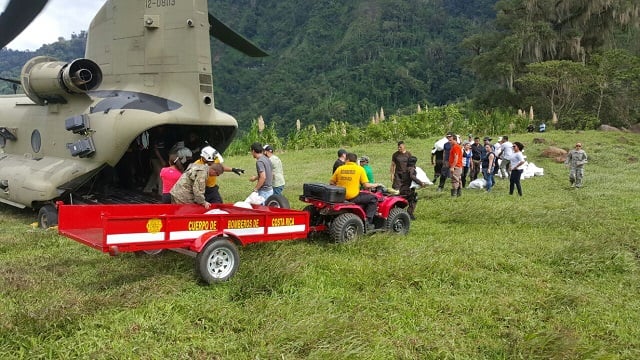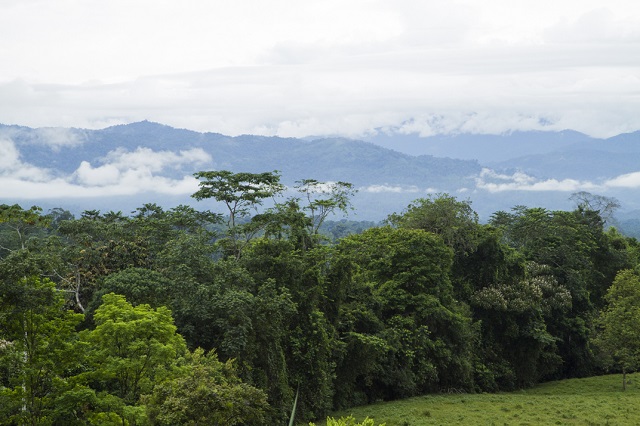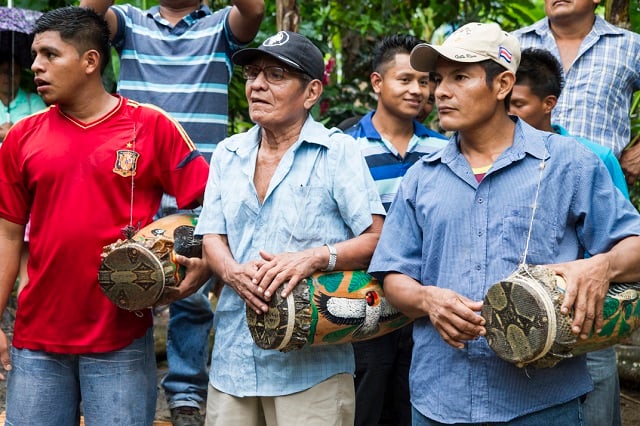
From the top of the great Talamaca mountain range in southern Costa Rica, you can see the Caribbean Sea and the houses of the Bribri and Cabécar Indigenous groups. According to their cosmology, their ancestors are in every tree, in every river and in every living being found in this reserve close to the border with Panama: The place is sacred. But to the Costa Rican government and the United States Southern Command, its value lies in its mineral deposits and oil.
Costa Rica hasn’t had an official army for the last 68 years. However, in 2013, people in the Talamaca region were surprised by the arrival of a helicopter full of uniformed military personnel, whom they immediately identified as being part of the United States Southern Command. The military personnel were playing the role of missionaries, giving Bibles away. However, simultaneously, they were carrying out various military training activities in the area around Alto Cuen, a Bribri community.
“They said they were missionaries, but no one believed them,” Bribri tribe member Leonardo Buitrago Morales told Truthout. “We knew they were looking for something more. The truth is that they want our lands and our forests to make money.”
In addition to the locals, the organization Ceiba Amigos de la Tierra, which promotes sustainable societies through social, economic and environmental justice, also spoke out against the arrival of the eight military personnel, who carried sophisticated equipment including GPS, cameras, altitude and topography meters, firearms and other weapons. The non-governmental organization even filed a complaint with the Costa Rican government, but “the Public Ministry never followed up on it. On the contrary, the complaint was dismissed,” says Henry Picado of the Costa Rican Biodiversity Network.
According to a report by researcher Irene Burgués Arrea, completed with support from The Nature Conservancy, the Talamanca region has been deemed a “priority site” by the US and Costa Rican governments. The Mesoamerican Integration and Development Project plans to build a complex energy infrastructure in this region, including highways and hydroelectric dams. In the Telire, Coen, Lari and Urén Rivers there are 16 hydroelectric projects planned that would affect the ecosystem of the Amistad International Park.
Additionally, studies show that the region is rich in minerals. In 1974, the US-based Alcoa company estimated that there is a 600,000-ton copper deposit in the Ñari River region of the Cabécar’s Chirripó reserve. Similarly, in the mid-1980s, the then-named Fischer-Watt Gold Company — also US based — analyzed soil samples from Tsuköt and found high amounts of gold, up to 7.7 particles per million.
“Humanitarian aid is just a pretense. They’ve already constructed a heliport. And local villagers have found tools used by miners. They’re carrying stones from our lands,” says Rafaela Torres, a member of the Bribri Indigenous group in Alto Uren, a village in the Telire area of Talamanca.
A History of US Involvement
“This isn’t the first time that this sort of thing has happened in Talamanca,” says Buitrago Morales. Since 2008, helicopters have arrived from the Costa Rican Social Security Fund (CCSS), which provides health, water and sanitation services to the public and private sectors. “We were surprised once more with the arrival of an helicopter from CRSS,” Buitrago Morales continues.
Since 2008, in an operation called the “Puentes de Vida para Talamanca” (Talamanca Bridge of Life) Initiative, 16 Southern Command soldiers in coordination with CCSS have helicoptered in 160,000 pounds of material in order to build suspension bridges in the area. “‘Humanitarian aid’ has long been shameless. We know that it’s a front to conduct mining and oil prospecting,” Picado says.
 The Talamanca mountain range is the highest elevation in the south of Central America. It extends from the southern part of the Central Valley of Costa Rica and continues through the territory of Panama. (Photo: Santiago Navarro F.)
The Talamanca mountain range is the highest elevation in the south of Central America. It extends from the southern part of the Central Valley of Costa Rica and continues through the territory of Panama. (Photo: Santiago Navarro F.)
Meanwhile, the CCSS is planning new incursions into the territory. In August 2016, it announced that it would use drones from the US company Zipline to deliver medicine in the Talamanca Health Area and Star Valley. “They called in all the people of the region and told us they’d be using drones, and said they needed our approval to build an airstrip for their equipment,” says Buitrago Morales. “They spoke of millions of dollars, but we didn’t believe them. They’re just interested in our lands. We don’t trust the government because it hasn’t shown a willingness to support its Indigenous people.”
The Role of the US Southern Command in Costa Rica
The governments of the US and Costa Rica do not make plain the ways in which they’re targeting Talamanca for transnational economic and military objectives. “They hardly ever make their strategic interests public. But we can tell when there are invaders and strange movements, because we know our territory,” Buitrago Morales says.
In 2009, the US Southern Command published a report titled “US Southern Command Strategy 2018: Friendship and Cooperation in the Americas,” in which it revealed its plans in Latin America and the Caribbean.
One of its key points is the importance of guaranteeing the supply of fossil fuels in the US to ensure continued economic growth. “According to the Department of Energy, three of the top four foreign energy suppliers to the US are located within the Western Hemisphere (Canada, Mexico and Venezuela). According to the Coalition for Affordable and Reliable Energy, the US will need 31 percent more petroleum and 62 percent more natural gas in the next two decades. As the US continues to require more petroleum and gas, Latin America is becoming a global energy leader with its large oil reserves and oil and gas production and supplies,” the report states.
In 1998, MKJ Xploration — a company that is part of a consortium including the then-named Harken Energy Corporation — was given the right to explore for fossil fuels in 5,634-square-kilometers in the Caribbean. This included four of the 22 oil blocks that the Costa Rican government had designated for exploration in 1994, affecting part of Talamanca. In 2000, six more blocks were also assigned to the Mallon Oil Company. All three of these companies are from the US.
The United States Southern Command reports that its mission is to “develop … military operations and to promote security cooperation to reach strategic objectives in North America with countries in Central and South America.” Its main lines of action, as outlined in an official note by the Latin American division of the US Army, are fighting the war on drugs and terrorism; providing humanitarian assistance; carrying out exercises and operations in collaboration with the Navy; establishing relations between the public and private sectors; and intervening in the theater of security and cooperation; among others.
Fighting “Drug Trafficking and Terrorism”
Ana Gabriel Zúñiga Aponte is the chief of staff of the Costa Rican Presidential House, and her position includes presiding over the Costa Rican Institute on Drugs and dialoguing with Indigenous groups. When asked about the flights and the presence of the Southern Command in Talamanca, Zúñiga Aponte told Truthout, “The United States’ collaboration with the Costa Rican government has focused on fighting drug trafficking, crime and money laundering. And in order to be effective in this area, investment in aerial surveillance systems and infrastructure is needed.”
According to Costa Rica’s US Embassy website, the Central American country received more than $25 million in assistance between 2009 and 2014 to support three priorities: borders, fair trials and “safe communities.”
Within the framework of fighting terrorism and drug trafficking, between 2011 and 2016, the Special Intervention Unit of Costa Rica participated in police and military activities called “Fuerzas Comando” along with the Southern Command. In May 2016, on the esplanade of the Marine Infantry base in Ancon, Peru, a military competition began, presided over by the chief of Intelligence and Operations Command Specialties of Peru, Maj.-Gen. Moisés Del Castillo Merino. The event lasted 10 days during which Special Forces of 20 North, Central and South American countries participated, including Costa Rica.
“For more than eight years, the Southern Command has been negotiating with the Costa Rican government, in particular offering international cooperation in the form of humanitarian aid and military training of police forces,” Picado says. “This training was put on display by the new government when it repressed protesters demonstrating against the privatization of health care.”
The Southern Command took another step to secure relations with Costa Rica in security matters — particularly in the fight against terrorism and drug trafficking — in 2011, when it financed and inaugurated a new Coast Guard station almost 975-meters high in Puntarenas on the central Pacific coast. The facility includes a new communications center, mooring posts, a maritime mechanics workshop and an extensive dock. “This dock will boost Coast Guard capabilities and increase collaboration between the United States and Costa Rica in the fight against drug trafficking,” Col. Norberto Cintron, chief engineer of the Southern Command, remarked at the opening.
According to Zuiri Méndez, coordinator of the University of Costa Rica’s (UCR) Socio-Environmental “Kiosk” Program, US vessels are allowed to ship to and from Costa Rican ports seamlessly. “For three years now, the Costa Rican Legislative Assembly has allowed American army fleets to use Costa Rican ports,” said sociologist Zuiri Méndez, who has been facilitating organizational strengthening in more than 12 Bribri and Cabécar communities in the Talamanca area since 2008 through a UCR program. “Additionally they can travel unencumbered throughout the country. And they have an agreement with the Ministry of Health allowing their aircraft to fly over all of Costa Rican airspace.”
Capitalizing on Disaster
 Indigenous Bribri people celebrate their resistance of several years against the commodification of their forests in the Cordillera de Talamanca, Costa Rica. (Photo: Santiago Navarro F.)
Indigenous Bribri people celebrate their resistance of several years against the commodification of their forests in the Cordillera de Talamanca, Costa Rica. (Photo: Santiago Navarro F.)
The CCSS and the Southern Command have a team of doctors who visit the village of Piedra Mesa, Telire, in Talamanca every three months. According to the official US Embassy website, these activities have been carried out by the Fund since 2010. “Thanks to the joint work carried out by the Southern Command of the United States, the Costa Rican Social Security Fund, the Ministry of Health, the Ministry of Security, Governance and Police, and Limón airport authorities, more than 500 residents of Piedra Mesa, Talamanca have received free medical care,” the Embassy states.
The Southern Command’s most recent opportunity to enter Talamanca’s most remote communities was Hurricane Otto, which passed through Costa Rica and Nicaragua on November 24, 2016. A few days later, it had mobilized four helicopters from the First Battalion’s 228th Air Regiment transporting food, clothing and medicine to the village of Piedra Mesa, Telire. This humanitarian mission was called “Operation Pura Vida,” and involved 16 military doctors, nurses, dentists and other specialists from the Bravo Joint Task Force, which operates from Soto Cano Air Base located in Honduras. Its staff is made up of more than 500 US military personnel and 500 Honduran and US civilians.
US Army Maj. Rosemary Reed participated in the operation, along with engineers and geologists who helped make key measurements to determine the carrying capacity of the rebuilt bridges, note locations and record the extent of damage. “The purpose of the FTC-Bravo carrying out this exercise is to test its ability to react to natural disasters and to interact with the local population in developing relationships with other entities in Central America,” claimed Capt. Lettishia Burchfied, the officer in charge of Operation Pura Vida.
However, some advocates don’t trust this synopsis of the US’s goals in the area. The FTC-Bravo carries out a variety of missions in Central and South America, ranging from supporting US government operations to countering transnational organized crime, as well as providing humanitarian assistance and support around natural disasters and development. According to Picado, the intervention that took place last fall is worrisome because, “It seems more like a pretext, since the effects of Hurricane Otto were minimal in Talamanca. They were almost null, in fact. The most affected areas were on the border with Nicaragua, in the northern region of Upala.”
So, why is the US sending significant numbers of people and supplies into the area?
“The Talamanca mountain range is being mapped by the United States to highlight the various minerals and oil that exist in the region,” Méndez says. “It’s clear that its presence in the region is because of those resources.”
The future of the Southern Command in Costa Rica cannot be predicted, but President Trump’s cabinet appointees may hold some clues. For instance, President Trump chose retired Gen. John Kelly to lead the Department of Homeland Security, a position that includes overseeing the enforcement of immigration laws. General Kelly served as chief of the Southern Command between 2012 and 2016, and was responsible for overseeing a rapid expansion of Special Forces in Latin America. He also encouraged and maintained military cooperation with key partners such as Colombia, Honduras and the rest of Central and South America, all within the framework of fighting drug trafficking and illegal immigration to the US.
“This nomination not only leaves the country of Costa Rica, but all of Latin America unsure about how geopolitical elements will play out,” Picado says.
4 Days Left: All gifts to Truthout now matched!
From now until the end of the year, all donations to Truthout will be matched dollar for dollar up to $44,000! Thanks to a generous supporter, your one-time gift today will be matched immediately. As well, your monthly donation will be matched for the whole first year, doubling your impact.
We have just 4 days left to raise $44,000 and receive the full match.
This matching gift comes at a critical time. As Trump attempts to silence dissenting voices and oppositional nonprofits, reader support is our best defense against the right-wing agenda.
Help Truthout confront Trump’s fascism in 2026, and have your donation matched now!